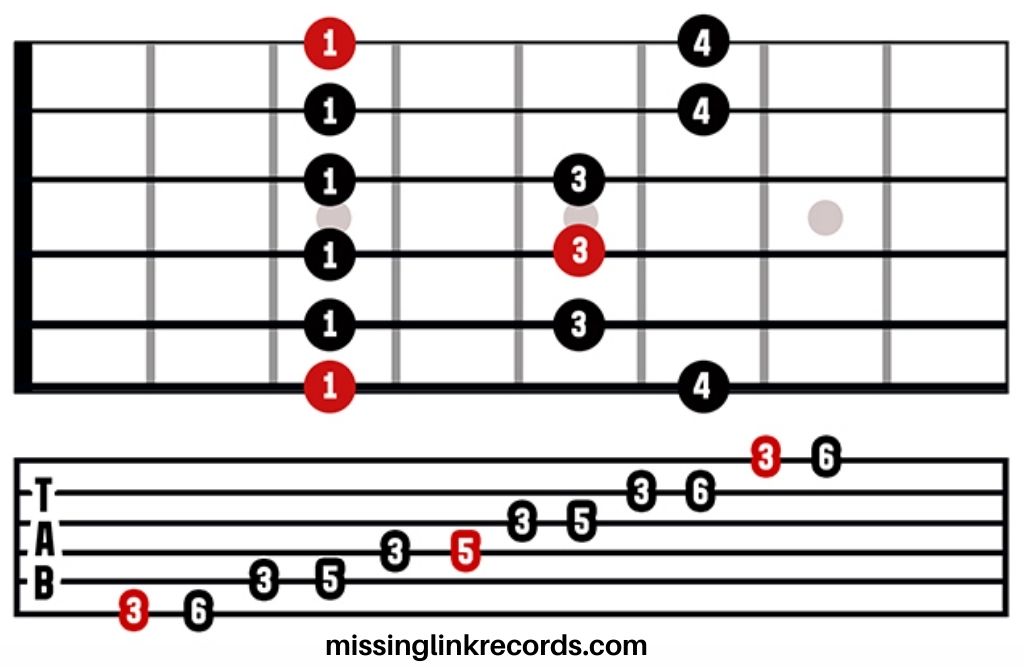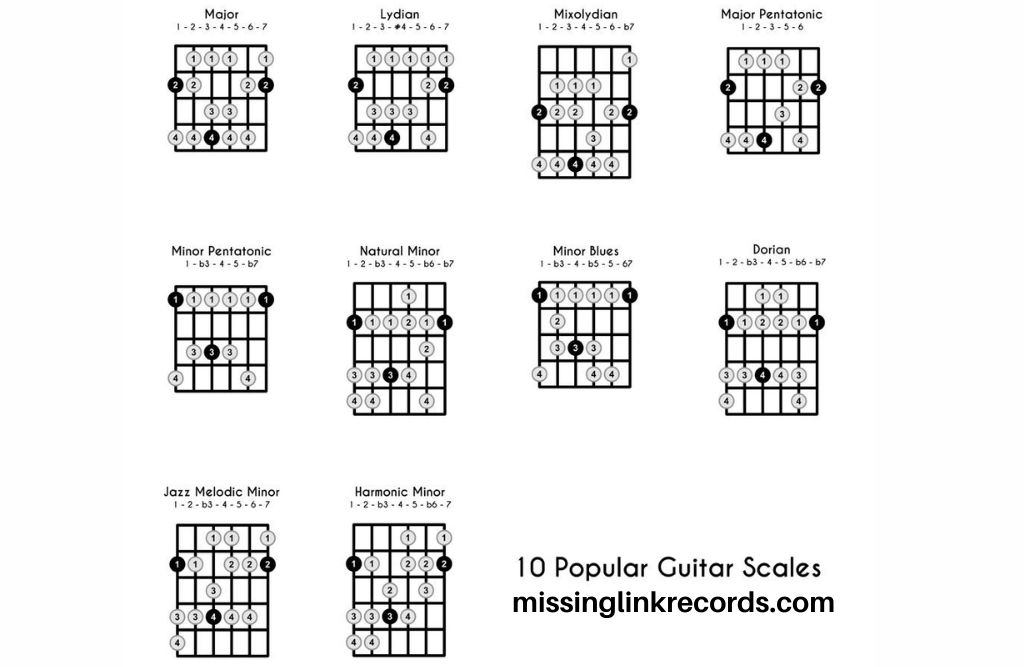What Are Scales In Guitar – Guide 2022

What are scales in guitar? As the name implies, a scale is an arrangement of notes arranged in a certain order and with the same tone. Guitar players must understand what scales are and how they work, as it is one of the most fundamental concepts in music theory. This article will explore some of the basics of scales and their uses. As mentioned above, scales are a series of pitches arranged in a particular way.
These pitches can include whole steps (two frets), half steps (one fret), and other intervals. A “whole step” is two frets on your guitar: C to Db is one whole step, while C to D is two whole steps (a major second). There are eight notes in an “octave,” such as C to C or E to E. The term “scale” refers only to these specific arrangements of pitches. It does not describe melodies or chord progressions.
- Music theory has a number of scale types. Still, for our purposes, we will focus on four main categories:
- The major scale (also called Ionian mode)
- Minor scale (also called Aeolian mode)
- Pentatonic scale guitar (also called the five-note scale)
- Chromatic scale (also known as the twelve-note scale)
- Each of these scales has its own sound, which will give you a range of options to choose from when you solo over a chord progression.
What are guitar scales used for?
Musicians use scales to organize notes in ascending or descending order. Playing a scale with your guitar is called “scaling the guitar.” Scales are built on intervals (the spaces between notes) and the key in which they are played. For example, no matter how you play it, the C-major scale uses only the white keys.
- Guitar scales are used for several things, including:
- Improving your dexterity on the guitar if you are a beginner.
- Make sure you have all the necessary skills to play certain songs.
- Improving and better understanding of music theory.
- Helping you improvise (play by ear).
- By giving your guitar solos a more polished sound, guitar scales are just as important as chords and riffs in playing a piece of music.
- They can also be used to help you write your songs.
How many guitar scales are there?
First, let’s define what a scale is. Scales consist of notes arranged in ascending or descending order following a specific pattern of intervals. There are many different scales because there are many different patterns of intervals. You can have as many patterns as you like, but your guitar has only 12 possible notes in any given key, so the number of patterns is limited.
- If we consider every possible pattern created with 12 notes, there would be 4,096 possibilities. It is a huge number.
- Thankfully, there are plenty of duplicates and redundancies in this list, so the actual number of usable scales is much smaller.
- If we take out the redundant scales and harmonically equivalent scales (scales that sound the same even though they are not), the number drops to 221.
There are many scales from which to compose your music, as you can see. But before you go trying to learn all 221, consider this: You may already be familiar with some commonly-used scales like the pentatonic scale guitar or blues scale guitar. And if you know how to use them effectively, you will master playing guitar in no time.
How to read guitar scales?
Knowing what scales are is the first step in learning how to read guitar scales. The major scale is the most common type of scale and has the following notes: C D E F G A B C. The next step is to learn the different scales, including minor scales, pentatonic scales, and chromatic scales.
- The achromatic scale is an ascending or descending sequence of twelve half-steps (one half-step per note).
- A minor scale is just a major scale with the third note lowered by one half-step, and a pentatonic scale is just a major scale with the fourth and seventh notes lowered by one half-step.
- The next step is to play these different scales on your guitar.
There are two ways to do this: You can either use a tuning for your guitar that matches the notes in a particular scale or learn how to play each note in the appropriate key position on your fretboard. Finally, you need to practice playing these scales to become comfortable playing them and creating.
What are scale notes on guitar?
What Are Root Notes In Guitar Scale? Scales on guitar are notes that form a cohesive melody when played in succession. The most basic scale on guitar is the pentatonic scale, which means it has five notes. It is essential to learn the notes of scales because they will make up the chords, riffs, and solos that you will play throughout your music career.
You can use it in popular songs and form the foundation for more complex scales. Besides that, you can play notes of each scale one after another in a specific sequence. For example, if you play a C major scale, you start with C and proceed to D, E, F, G, A, and B before ending on C again.
What guitar scales should I learn first?
There are many things to learn when you are starting on guitar: chords and scales, techniques, even songs, and there is no clear-cut way to go about it. Moreover, it is easy to feel overwhelmed with all the information. There are also probably as many opinions as there are guitar players. So when you are thinking about what scales to learn first, remember that the most important thing is to have fun.
- Play what you enjoy, and eventually, you will find yourself getting better at whatever you play.
- Some scales will be more valuable than others, depending on the type of music you want to play.
- Since it is all about having fun and developing your skills simultaneously, I recommend learning the most common major and minor scales first. These are:
- The Aeolian (or “natural minor”) scale
- The C major scale
- The G major scale
You will notice that these three scales all use different key signatures, but they are built similarly. Once you know one of them well enough, it will be easier to learn the rest because they have many notes in common. A major scale has many notes in common with a C major.

How do you play scales on guitar?
Learning to play the guitar can be a rewarding and fun experience. There are many different techniques and styles to learn, and there are plenty of ways you can make playing the guitar something entirely your own. One of the first things you should learn when you pick up a guitar is how to play scales.
- Scales are an essential part of any musician’s repertoire, and they serve as the foundation for all other musical elements.
- They will help you learn chords to memorize notes, so you must master them.
- There are many different scales, but major scales are the most common.
- If you are new to playing guitar, this is where you will want to start.
- Major scales are very easy to learn and provide a great introduction to the basics of how music works.
- The first thing you need to do is find the starting point on your guitar.
- You should be sitting comfortably with your guitar in hand and your fingers positioned over the strings to be ready to play but not currently touching any strings or frets.
- Start by placing your index finger on the low E string, the thickest string at the bottom of your guitar.
- Press down firmly but not too hard, just enough to feel the string pressing back against your fingertip.
- Move your finger up one fret toward the headstock of your guitar, and press down again just as firmly as before.
- The next fret up from there is where you are headed.
Now do the same thing with each of your other fingers, pressing them down one at a time onto the next open fret (this time on the A string) until all four fingers are on four separate frets. Once you have found this position, look at where your first finger is resting on note E. Your second finger is on A, your third finger on D, and your fourth finger is on G. It is an E major scale.
How Many Guitar Scales Are There
Now you have to pick it. It is easier than it seems at first glance. Pick each string once with your pick, and then move on to the next one. If you are right-handed, start with the low E string (sixth) and finish with the high E string (first). Remember, once you have picked all six strings each, you start over from the beginning. Move up two frets and do it again. Keep doing this until you get to the 12.
How long does it take to learn scales on guitar?
The time it takes to learn scales on guitar depends on your current level of playing the guitar. If you are a beginner and have never played the guitar before, it will take at least a few months before you can learn to play basic scales. Moreover, if you are an intermediate player and have been playing for a while now, it should not take more than a couple of weeks to learn basic scales.
In the same way, if you are an advanced player who has played for many years and is looking to challenge yourself with more difficult scales, it may take up to a month to learn new scales properly. Learning scales is essential in music because they are used as reference points when writing melodies or improvising solos over chord progressions.
PDFs
- All Guitar Scales Pdf
- Beginner Guitar Scales Pdf
Wrapping it up
Scales are simply a series of notes that go octave to octave – or twice the frequency. Why is it important to know “what are scales in guitar”? Anything that is not considered music theory is just artistry. The more you know about these things (Arpeggios and Scales), the more creative you can be when playing guitar.
Related Searches
- Pentatonic Scale Guitar
- Blues Scales Guitar
- Guitar Scales Tabs
- All Guitar Scales Pdf
- How Many Guitar Scales Are There
- How To Read Guitar Scales
- Beginner Guitar Scales Pdf
- What Are Root Notes In Guitar Scales
Also Visit: What Key Is Guitar In



